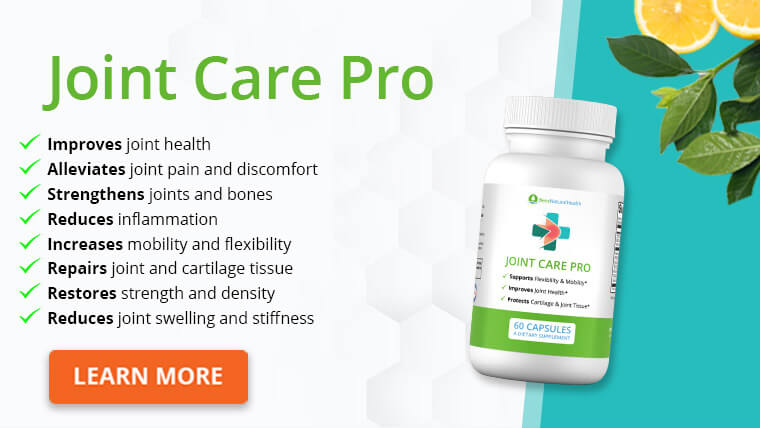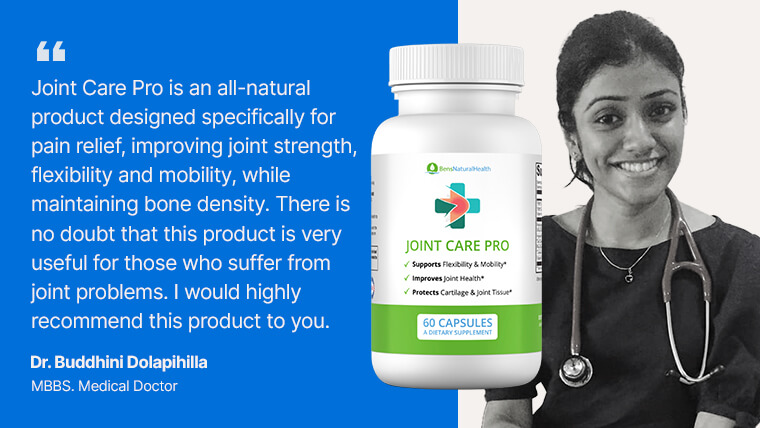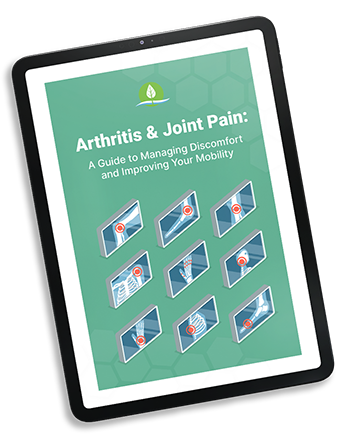Arthritis is a common condition that affects over 350 million people around the globe.
Pain and other symptoms of arthritis can seriously affect your daily activities and reduce your quality of life.
If you suffer from this condition, you know that there are loads of medications designed to relieve its symptoms.
You also know that these medications come with a long list of adverse side effects.
If you are looking for great natural alternatives that have little or no side effects, this article is for you.
Read on to learn about proven home remedies that can help you manage your arthritis symptoms while providing you with several other health benefits.
What is arthritis?
The term “arthritis” refers to swelling and tenderness of a joint or group of joints. It is a degenerative disease that often affects the aging population and is more common in women than it is in men. Based on the cause, there are many different types of arthritis.
Osteoarthritis is the most common type and is a prevalent cause of disability and chronic pain in people in the US.
It most commonly affects the knee – up to 80% of cases – with as much as 18% of adults 45 years and older in the US suffering from knee osteoarthritis.
Osteoarthritis occurs when the cartilage between the bones of the joints gradually breakdown. Because of this, it is often called “wear and tear” arthritis.
Other types of arthritis include:
- Rheumatoid arthritis: This is an autoimmune disease that occurs when the immune system attacks the body’s joints, causing inflammation and pain.
- Gout: Occurs as a result of a buildup of uric acid in the joints resulting in inflammation.
- Psoriatic arthritis: This is a type of arthritis that affects people with a skin condition known as psoriasis.
Some risk factors for developing arthritis include:
- Family history: Many forms of arthritis have a hereditary component.
- Age: The risk of certain types of arthritis increases with age.
- Being female: Rheumatoid arthritis is more common in women, and gout is more common in men. However, arthritis is more common in women overall.
- Previous joint injury: having a previous injury in a joint increases the risk of developing arthritis in that joint.
- Being overweight or obese: Your bones and joints help to support your body. Having extra pounds exerts stress and pressure on your joints, particularly the knees, hips, and spine.
Get Your FREE Arthritis Guide
- Learn how to naturally improve your arthritis symptoms
- Dietary recommendations, exercise guides, supplements, and lifestyle changes
- Developed exclusively by our medical doctor
Signs of arthritis
While there are some differences in the signs and symptoms of various forms of arthritis, there are certain features that are common to all types. These include:
- Joint pain
- Joint stiffness
- Reduced flexibility
- Popping sounds when using the affected joint
- Redness
- Swelling
- Warmth
What does arthritis pain feel like?
The pain of arthritis, medically known as arthralgia, differs from person to person and also depends on the cause.
Osteoarthritis usually causes a dull ache deep in the affected joint. It may occur intermittently, or it may be constant.
Osteoarthritis pain often comes on after a lot of activity with the affected joint and gets better with rest.
Rheumatoid arthritis can cause burning or throbbing pain in the joints. Unlike osteoarthritis, people with rheumatoid arthritis usually feel the pain first thing in the morning, and it gets better as the day goes on.

7 home remedies for arthritis
Below we discuss some remedies for arthritis that you can try at home. These remedies may not immediately relieve arthritis symptoms, but they can help you experience long-term improvement. They also provide loads of other health benefits.
1) Weight loss
As mentioned above, being obese or overweight increases your risk of developing arthritis. It also has a huge impact on the severity of symptoms.
The more a person weighs, the more pressure is exerted on the joints. This leads to the worsening of symptoms and faster disease progression.
According to CDC, for every pound of weight lost, there is a 4-pound decline in the load exerted on the knee.
The American College of Rheumatology and Arthritis Foundation (ACR/AF) strongly recommends weight loss in obese or overweight patients with arthritis.
Weight loss, achieved through exercise and diet modification, will not only help to relieve arthritis symptoms, but it offers lots of other health benefits, including a reduction in blood sugar and cholesterol levels.
2) Low to moderate-intensity exercises
Although exercising may be the last thing on your mind when your joints hurt, getting physically active has been shown in studies to be beneficial in relieving arthritis pain and other symptoms.
Apart from contributing to weight reduction, regular exercise increases strength in the muscles of the affected joint and reduces bone loss.
Exercise also offers nourishment to and improves lubrication of joint cartilages resulting in decreased stiffness and pain, which improves motion range.
Low to moderate-intensity exercises are good for people with arthritis because they put little to no stress on the joints.
Avoid strenuous exercises that may aggravate the wear and tear of your joints.
Water exercises like swimming, water aerobics, and water walking are some of the best low-intensity exercises for arthritis relief.
Water exercises are particularly great because the relatively weightless environment and support from the water help to control painful movement in joints affected by arthritis.
Other low-intensity exercises you can try out include brisk walking or treadmill walking, cycling, and dancing. All of these contribute to improved circulation around affected joints.
3) Turmeric
Adding turmeric to your food and drinks may just be what you need to fight arthritis pain.
Turmeric is a popular yellow spice that contains potent anti-inflammatory properties and anti-oxidants that could help reduce inflammation in the joints.
One major anti-inflammatory chemical in turmeric is curcumin. It helps to lower the level of certain enzymes that cause inflammation.
Apart from including turmeric in your diet, there are lots of supplements that contain curcumin and other active ingredients of turmeric.
Certain studies show improvement in joint inflammation within weeks of turmeric supplementation.
4) Omega-3 fatty acids
Omega-3 fatty acids are potent anti-inflammatory substances that may help reduce joint tenderness and stiffness.
We cannot produce omega-3 fatty acids ourselves and, therefore, have to consume them.
They occur naturally in fish (particularly fatty fish like tuna, herring, salmon, mackerel, and sardines) and other seafood.
They are also found in nuts such as walnuts and seeds such as pumpkin seeds. Certain plant oils, such as canola and flaxseed oil, also contain omega-3 fatty acids.
Some foods like eggs, milk, and yogurt are fortified by manufacturers with omega-3 fatty acids.
There are lots of dietary supplements that contain omega-3 fatty acids. These include krill oil, fish oil, cod liver oil, and algal oil (a vegetarian alternative derived from algae). These supplements are available in a wide variety of doses and forms.
5) Adequate hydration
Hydration has a whole lot of benefits for your body. Since synovial fluid is mostly made up of water, staying hydrated helps stimulate more production of synovial fluid, which cushions and lubricates the joint. This reduces flare-ups and inflammation around the joint.
Staying hydrated also helps in promoting quick cartilage recovery while encouraging the growth of new cells.
6) Fruits and vegetables
Although no diet can miraculously cure arthritis, incorporating fruits and vegetables into your daily diet is beneficial for the management of arthritic symptoms.
Fruits and vegetables such as carrots, orange, yellow/red bell peppers, apricots, collard greens, Kale, tangerines, papayas, spinach, pumpkins, acorn squash, and sweet potatoes contain carotenoids called beta-cryptoxanthin and zeaxanthin.
These are anti-inflammatory chemicals that can help keep your joints healthy and reduce joint tenderness.
7) Less red meat
While red meat is rich in proteins and other vital nutrients that are needed for the proper functioning of your body, studies have shown a direct link between red meat and inflammation.
Diets high in red and processed meats were shown to have high levels of inflammatory markers such as C-reactive protein, Interleukin-6(IL-6), and homocysteine.

Natural arthritis pain relief
If you would like to stray away from medication, here are some natural arthritis pain relievers you can try out:
1) Heat therapy
Heat therapy is an easy and cheap way to manage arthritis stiffness and pain at home. Methods include using a moist heating pad, applying a warm compress on the affected area, taking a warm shower or bath, or using an electric blanket.
Heat therapy works by:
- Causing blood vessels to dilate, which increases blood flow to and nourishment of the joints and stimulates the healing of damaged tissue.
- Reducing joint stiffness by increasing flexibility of the muscles and connective tissue.
- Stimulating synovial joint fluid production which increases joint lubrication and delivery of nutrients to joint tissue.
- Distracting the brain from the pain – heat can stimulate sensory receptors in the skin that decrease the transmission of pain signals to the brain.
2) Menthol creams
Menthol is obtained from peppermint oil and can be an effective way of temporarily relieving arthritis pain.
Menthol creates a cooling sensation that distracts one from the pain.
3) Capsaicin ointment
Capsaicin ointment is derived from chili peppers and is a topical ointment that can be bought over the counter or can be made at home.
Capsaicin works by making the skin surrounding the affected area insensitive to pain. It does this by blocking the transmission of pain signals from the joint to the brain. It also has anti-inflammatory effects when applied to affected joints.
4) Meditation
Certain studies show that meditation can be an effective way of relieving arthritic symptoms.
There are different forms of meditation, and one of the most popular is mindfulness meditation. This is a technique that is based on being completely present in the moment.
Practicing mindfulness helps distract the mind from the pain and offers relaxation. It can also help you approach pain differently and diminish pain intensity.
5) Massage therapy
Massages are a great method for relieving or reducing arthritis pain and swelling. Massages help to relax the muscles around the joints, thereby reducing the strain on them. It also increases blood flow to the joints.
What’s more, massages have been proven to release “feel good” hormones like serotonin which improves mood and reduces stress hormones that can contribute to arthritis flare-ups.
6) Acupuncture
Acupuncture is a component of traditional Chinese medicine that involves the insertion of very thin needles through the skin at cardinal points on the body. Acupuncture is most commonly used to treat pain.
While there is not much research on the efficacy of acupuncture in managing arthritis, some studies show that inserting an acupuncture needle may enhance the effects of pain-relieving chemicals in our bodies, like endorphin, dynorphin, and encephalin.
Ben’s Joint Care Pro
Joint Care Pro, our joint health supplement, contains natural, proven ingredients that support joint care and joint health.

It is designed to improve mobility and flexibility, reduce joint pain, restore joint strength, protect cartilage and joint tissue, and rebuild strength and density.
This supplement is particularly useful for those with joint problems, especially those who suffer from arthritis.
Conclusion
Arthritis is a condition characterized by joint pain and inflammation that affects millions of adults worldwide.
There are tons of arthritis drugs available. However, most of these drugs have a long list of side effects.
Home remedies and natural pain relievers for arthritis include omega-3 fatty acids, capsaicin ointment, menthol creams, acupuncture, and massage therapy.
Studies have shown that these remedies can be effective at relieving symptoms. The best part is they do this with little or no side effects and come along with many additional health benefits.
Explore More








